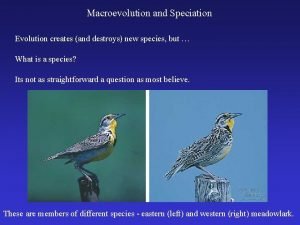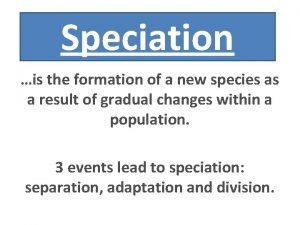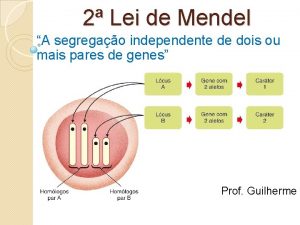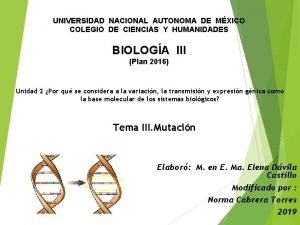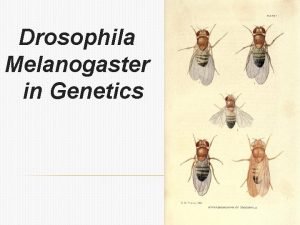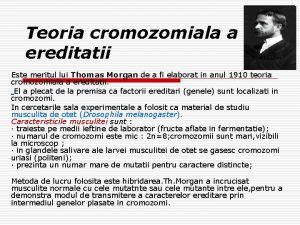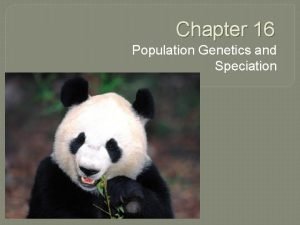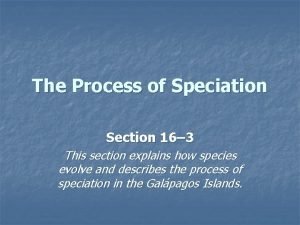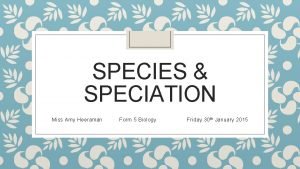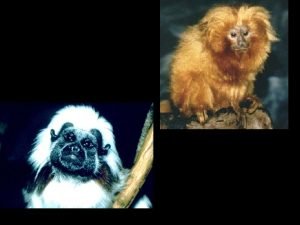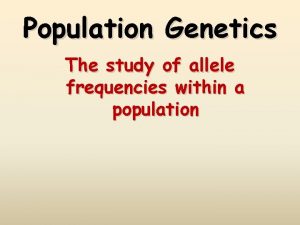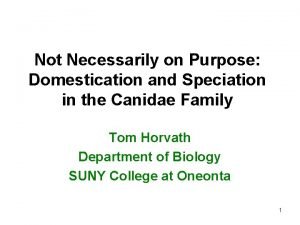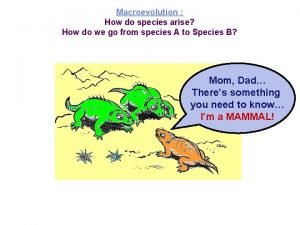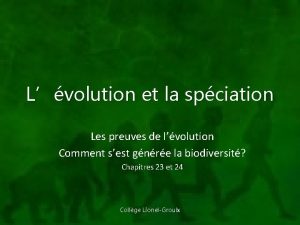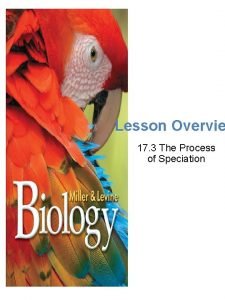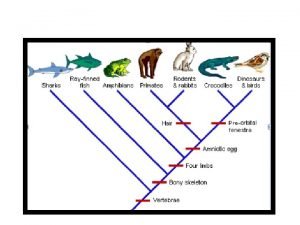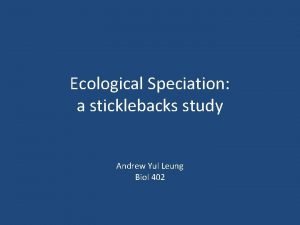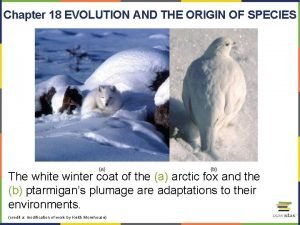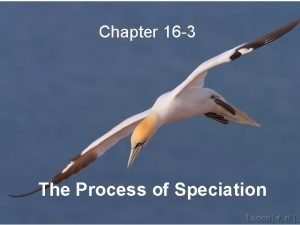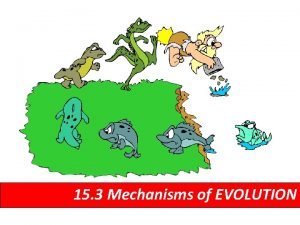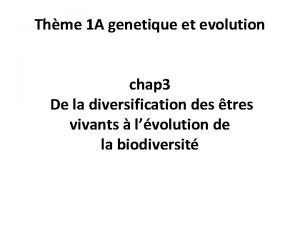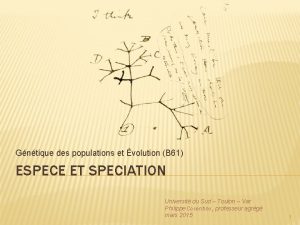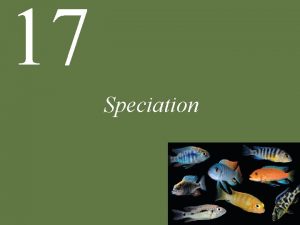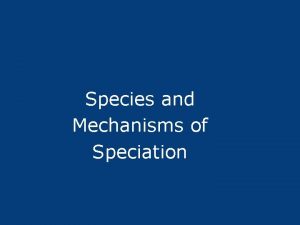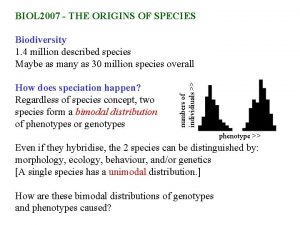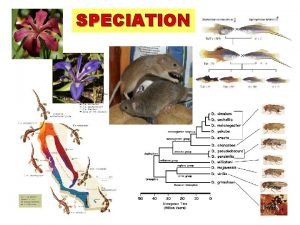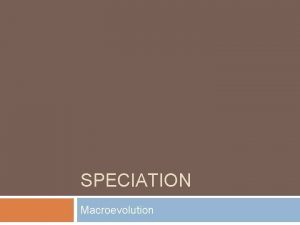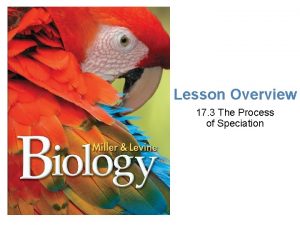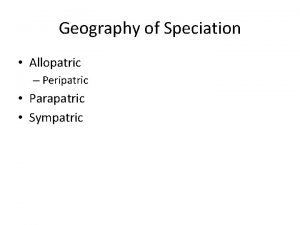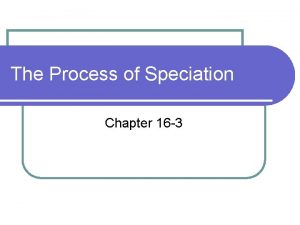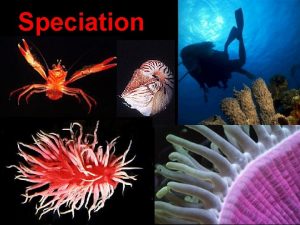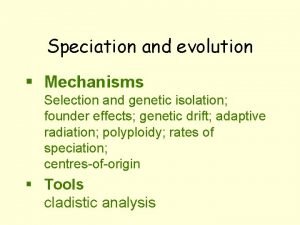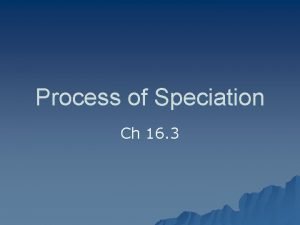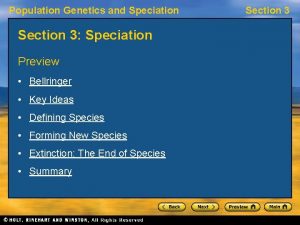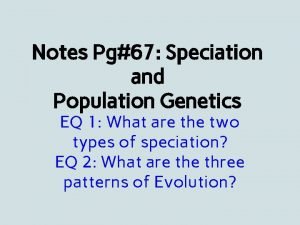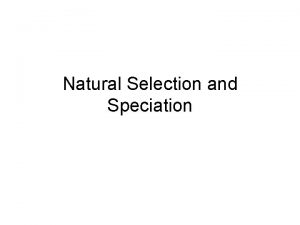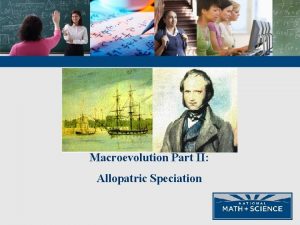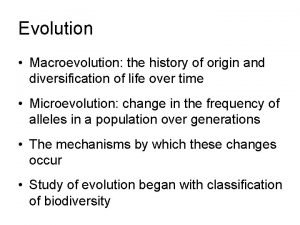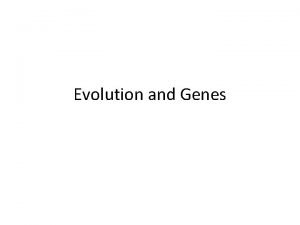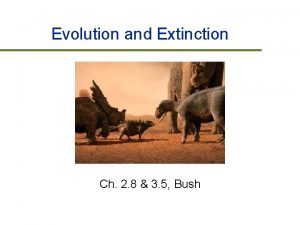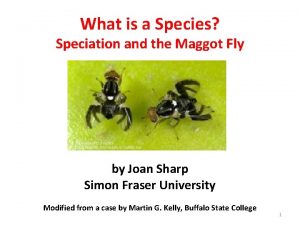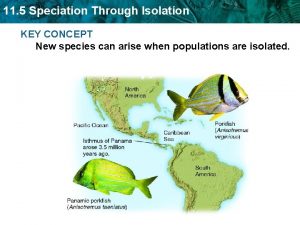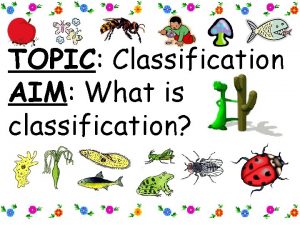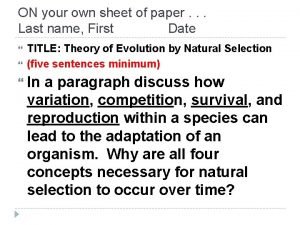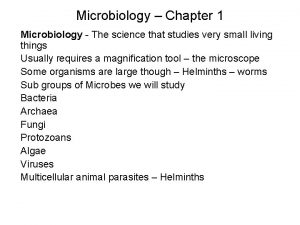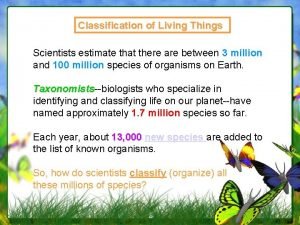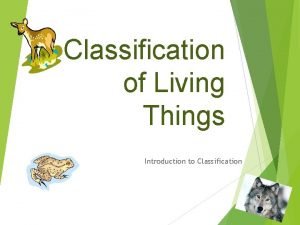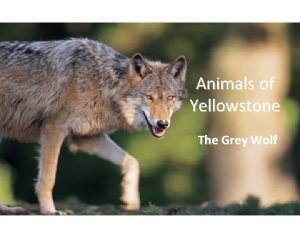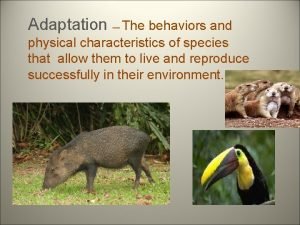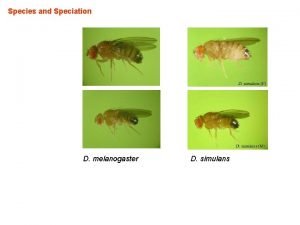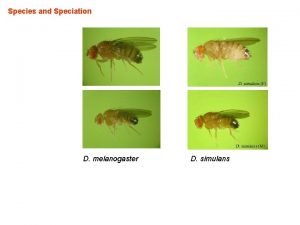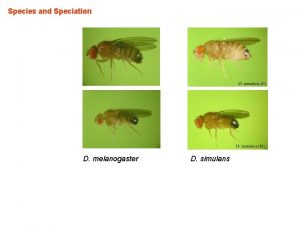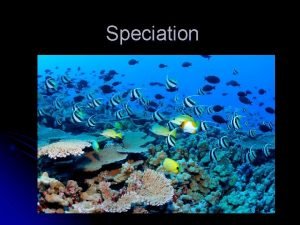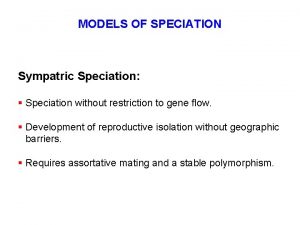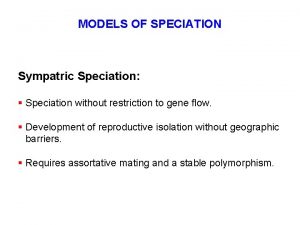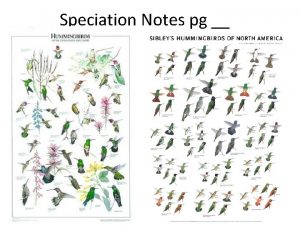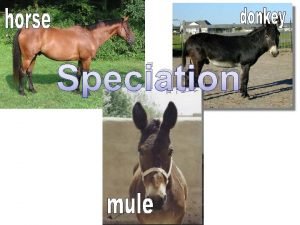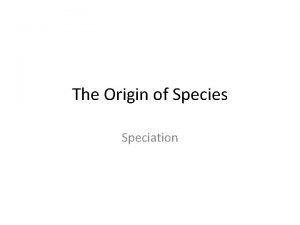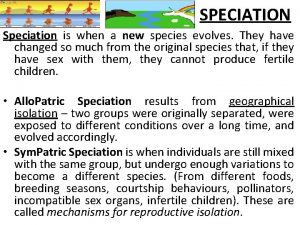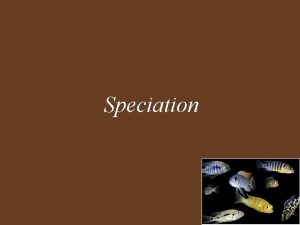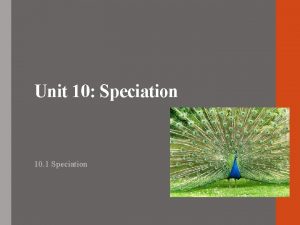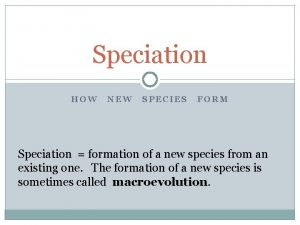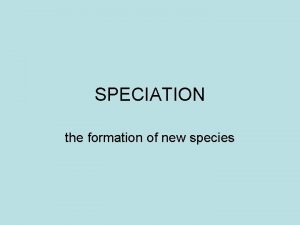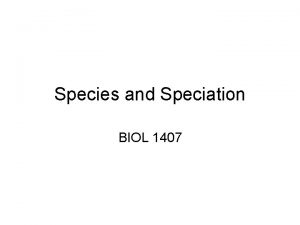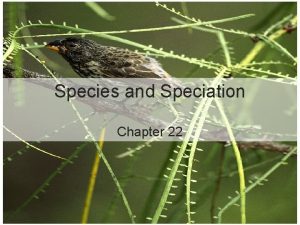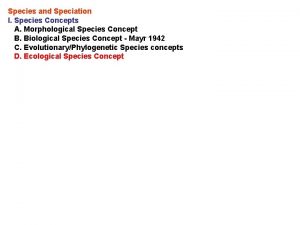Species and Speciation D melanogaster D simulans Species























































- Slides: 55

Species and Speciation D. melanogaster D. simulans

Species and Speciation I. Species Concepts

Species and Speciation I. Species Concepts How we define a species depends on the goal we have in mind.

Species and Speciation I. Species Concepts How we define a species depends on the goal we have in mind. Are we categorizing existing or fossil organisms?

Species and Speciation I. Species Concepts How we define a species depends on the goal we have in mind. Are we categorizing existing or fossil organisms? Are we trying to understand correlates between populations adapting to different environments?

Species and Speciation I. Species Concepts How we define a species depends on the goal we have in mind. Are we categorizing existing or fossil organisms? Are we trying to understand correlates between populations adapting to different environments? Are we trying to reconstruct phylogenies?

Species and Speciation I. Species Concepts A. Morphological Species Concept

Species and Speciation I. Species Concepts A. Morphological Species Concept - Categorical/'essential' in a platonic sense; based on morphological similarity to a 'type' specimen

Species and Speciation I. Species Concepts A. Morphological Species Concept - Categorical/'essential' in a platonic sense; based on morphological similarity to a 'type' specimen - Useful, but many species are polymorphic and some sibling species are indistinguishable morphologically. H. erato D. melanogaster (M)

Species and Speciation I. Species Concepts A. Morphological Species Concept - Categorical/'essential' in a platonic sense; based on morphological similarity to a 'type' specimen - Useful, but many species are polymorphic and some sibling species are indistinguishable morphologically. - Nonetheless, for dead or fossilized specimens, the phenotype is all we might have to analyze. As such, there are ways of quantifying the phenotype and defining "phenetic" species. . . by quantifying the within-group phenotypic variation, statistical analysis can ascertain whether a novel individual lies within that typical range. old species New Species!!

Species and Speciation I. Species Concepts A. Morphological Species Concept - Categorical/'essential' in a platonic sense; based on morphological similarity to a 'type' specimen - Useful, but many species are polymorphic and some sibling species are indistinguishable morphologically. - Nonetheless, for dead or fossilized specimens, the phenotype is all we might have to analyze. As such, there are ways of quantifying the phenotype and defining "phenetic" species. . . by quantifying the within-group phenotypic variation, statistical analysis can ascertain whether a novel individual lies within that typical range. Problem. . . need a pretty good sample to describe within-group variation with confidence. old species New Species?

Species and Speciation I. Species Concepts A. Morphological Species Concept B. Biological Species Concept - Mayr 1942

Species and Speciation I. Species Concepts A. Morphological Species Concept B. Biological Species Concept - Mayr 1942 "Groups of actually or potentially interbreeding populations that are reproductively isolated from other such groups"

Species and Speciation I. Species Concepts A. Morphological Species Concept B. Biological Species Concept - Mayr 1942 "Groups of actually or potetially interbreeding populations that are reproductively isolated from other such groups" - Biological units are genetically defined; reproductive isolation makes populations different from one another, creating new units. So, reproductive isolation is the key characteristic of a species.

Species and Speciation I. Species Concepts A. Morphological Species Concept B. Biological Species Concept - Mayr 1942 "Groups of actually or potetially interbreeding populations that are reproductively isolated from other such groups" - Biological units are genetically defined; reproductive isolation makes populations different from one another, creating new units. So, reproductive isolation is the key characteristic of a species. - Limitations:

Species and Speciation I. Species Concepts A. Morphological Species Concept B. Biological Species Concept - Mayr 1942 "Groups of actually or potetially interbreeding populations that are reproductively isolated from other such groups" - Biological units are genetically defined; reproductive isolation makes populations different from one another, creating new units. So, reproductive isolation is the key characteristic of a species. - Limitations: - Process may be continuous - where do you draw the "line" of isolation?

Species and Speciation I. Species Concepts A. Morphological Species Concept B. Biological Species Concept - Mayr 1942 "Groups of actually or potetially interbreeding populations that are reproductively isolated from other such groups" - Biological units are genetically defined; reproductive isolation makes populations different from one another, creating new units. So, reproductive isolation is the key characteristic of a species. - Limitations: - not applicable to asexual species

Species and Speciation I. Species Concepts A. Morphological Species Concept B. Biological Species Concept - Mayr 1942 "Groups of actually or potetially interbreeding populations that are reproductively isolated from other such groups" - Biological units are genetically defined; reproductive isolation makes populations different from one another, creating new units. So, reproductive isolation is the key characteristic of a species. - Limitations: - not applicable to asexual species - hybridization occurs in nature, even between otherwise 'good' species. Natural variability is not strictly discontinuous, so pigeon-holing on any grounds will be wrong in some cases. It becomes a matter of degree. The best example are "Ring Complexes". . . series of species which breed with neighboring species but the 'end' species do not. Salamanders in California, Gulls in circumpolar regions.

Ring Species Divergence that correlates with geographical distance can create interesting patterns on a spherical globe, or around a geographical feature.

Ring Species Divergence that correlates with geographical distance can create interesting patterns on a spherical globe, or around a geographical feature.

Ring Species Divergence that correlates with geographical distance can create interesting patterns on a spherical globe, or around a geographical feature.

Species and Speciation I. Species Concepts A. Morphological Species Concept B. Biological Species Concept - Mayr 1942 "Groups of actually or potetially interbreeding populations that are reproductively isolated from other such groups" - Biological units are genetically defined; reproductive isolation makes populations different from one another, creating new units. So, reproductive isolation is the key characteristic of a species. - Limitations: - not applicable to asexual species - hybridization occurs in nature, even between otherwise 'good' species. Natural variability is not strictly discontinuous, so pigeon-holing on any grounds will be wrong in some cases. It becomes a matter of degree. The best example are "Ring Complexes". . . series of species which breed with neighboring species but the 'end' species do not. Salamanders in California, Gulls in circumpolar regions. - Allopatric populations: Potential interbreeding means that populations that are spatially separated and morphologically/genetically distinct may be in the same species.

Species and Speciation I. Species Concepts II. Making Species - Reproductive Isolation A. Pre-Zygotic Barriers

Species and Speciation I. Species Concepts II. Making Species - Reproductive Isolation A. Pre-Zygotic Barriers 1. Geographic Isolation (large scale or habitat)

Species and Speciation I. Species Concepts II. Making Species - Reproductive Isolation A. Pre-Zygotic Barriers 1. Geographic Isolation (large scale or habitat) 2. Temporal Isolation

Species and Speciation I. Species Concepts II. Making Species - Reproductive Isolation A. Pre-Zygotic Barriers 1. Geographic Isolation (large scale or habitat) 2. Temporal Isolation 3. Behavior Isolation - don't recognize one another as mates

Species and Speciation I. Species Concepts II. Recognizing Species III. Making Species - Reproductive Isolation A. Pre-Zygotic Barriers 1. Geographic Isolation (large scale or habitat) 2. Temporal Isolation 3. Behavior Isolation - don't recognize one another as mates 4. Mechanical isolation - genitalia don't fit

Species and Speciation I. Species Concepts II. Making Species - Reproductive Isolation A. Pre-Zygotic Barriers 1. Geographic Isolation (large scale or habitat) 2. Temporal Isolation 3. Behavior Isolation - don't recognize one another as mates 4. Mechanical isolation - genitalia don't fit 5. Gametic Isolation - gametes transfered but sperm can't fertilize egg

Species and Speciation I. Species Concepts II. Making Species - Reproductive Isolation A. Pre-Zygotic Barriers 1. Geographic Isolation (large scale or habitat) 2. Temporal Isolation 3. Behavior Isolation - don't recognize one another as mates 4. Mechanical isolation - genitalia don't fit 5. Gametic Isolation - gametes transfered but sperm can't fertilize egg B. Post-Zygotic Isolation

Species and Speciation I. Species Concepts II. Making Species - Reproductive Isolation A. Pre-Zygotic Barriers 1. Geographic Isolation (large scale or habitat) 2. Temporal Isolation 3. Behavior Isolation - don't recognize one another as mates 4. Mechanical isolation - genitalia don't fit 5. Gametic Isolation - gametes transfered but sperm can't fertilize egg B. Post-Zygotic Isolation 1. Genomic Incompatibility - zygote dies

Species and Speciation I. Species Concepts II. Making Species - Reproductive Isolation A. Pre-Zygotic Barriers 1. Geographic Isolation (large scale or habitat) 2. Temporal Isolation 3. Behavior Isolation - don't recognize one another as mates 4. Mechanical isolation - genitalia don't fit 5. Gametic Isolation - gametes transfered but sperm can't fertilize egg B. Post-Zygotic Isolation 1. Genomic Incompatibility - zygote dies 2. Hybrid Inviability - F 1 has lower survival

Species and Speciation I. Species Concepts II. Making Species - Reproductive Isolation A. Pre-Zygotic Barriers 1. Geographic Isolation (large scale or habitat) 2. Temporal Isolation 3. Behavior Isolation - don't recognize one another as mates 4. Mechanical isolation - genitalia don't fit 5. Gametic Isolation - gametes transfered but sperm can't fertilize egg B. Post-Zygotic Isolation 1. Genomic Incompatibility - zygote dies 2. Hybrid Inviability - F 1 has lower survival 3. Hybrid Sterility - F 1 has reduced reproductive success

Species and Speciation I. Species Concepts II. Making Species - Reproductive Isolation A. Pre-Zygotic Barriers 1. Geographic Isolation (large scale or habitat) 2. Temporal Isolation 3. Behavior Isolation - don't recognize one another as mates 4. Mechanical isolation - genitalia don't fit 5. Gametic Isolation - gametes transfered but sperm can't fertilize egg B. Post-Zygotic Isolation 1. Genomic Incompatibility - zygote dies 2. Hybrid Inviability - F 1 has lower survival 3. Hybrid Sterility - F 1 has reduced reproductive success 4. F 2 breakdown - F 1's survive but F 2's have incompatible combo's of genes

Species and Speciation I. Species Concepts II. Making Species - Reproductive Isolation III. Speciation

Species and Speciation I. Species Concepts II. Making Species - Reproductive Isolation III. Speciation is not a goal, or a selective product of adaptation. It is simply a consequence of genetic changes that occurred for other reasons (selection, drift, mutation, etc. ).

Species and Speciation I. Species Concepts II. Making Species - Reproductive Isolation III. Speciation A. Modes:

Species and Speciation I. Species Concepts II. Making Species - Reproductive Isolation III. Speciation A. Modes: 1. Allopatric: Divergence in geographically separate populations - Vicariance - range divided by new geographic feature A B C

III. Speciation A. Modes: 1. Allopatric: Divergence in geographically separate populations - Vicariance - range divided by new geographic feature - Peripatric - divergence of a small migrant population A B

III. Speciation A. Modes: 1. Allopatric: Divergence in geographically separate populations - Vicariance - range divided by new geographic feature - Peripatric - divergence of a small migrant population 2. Parapatric - neighboring populations diverge, even with gene flow

III. Speciation A. Modes: 1. Allopatric: Divergence in geographically separate populations - Vicariance - range divided by new geographic feature - Peripatric - divergence of a small migrant population 2. Parapatric - neighboring populations diverge, even with gene flow

2. Parapatric - neighboring populations diverge, even with gene flow Hybrid Backcross? ? Hybrid

III. Speciation A. Modes: 1. Allopatric: Divergence in geographically separate populations - Vicariance - range divided by new geographic feature - Peripatric - divergence of a small migrant population 2. Parapatric - neighboring populations diverge, even with gene flow 3. Sympatric: Divergence within a single population

3. Sympatric: Divergence within a single population Maynard Smith (1966) - hypothesized this was possible if there was disruptive selection within a population - perhaps as a specialist herbivore/parasite colonized and adapted to a new host.

3. Sympatric: Divergence within a single population Maynard Smith (1966) - hypothesized this was possible if there was disruptive selection within a population - perhaps as a specialist herbivore/parasite colonized and adapted to a new host. Example: Hawthorn/Apple Maggot Fly (Rhagoletis pomonella) Hawthorn maggot fly is a native species that breeds on Hawthorn (Crataegus sp. )

3. Sympatric: Divergence within a single population Maynard Smith (1966) - hypothesized this was possible if there was disruptive selection within a population - perhaps as a specialist herbivore/parasite colonized and adapted to a new host. Example: Hawthorn/Apple Maggot Fly (Rhagoletis pomonella) Europeans brought apples to North America. They are in the same plant family (Rosaceae) as Hawthorn.

3. Sympatric: Divergence within a single population Maynard Smith (1966) - hypothesized this was possible if there was disruptive selection within a population - perhaps as a specialist herbivore/parasite colonized and adapted to a new host. Example: Hawthorn/Apple Maggot Fly (Rhagoletis pomonella) Europeans brought apples to North America. They are in the same plant family (Rosaceae) as Hawthorn. In 1864, apple growers noticed infestation by Apple Maggot flies. . . which were actually just "hawthorn flies". . .

3. Sympatric: Divergence within a single population Maynard Smith (1966) - hypothesized this was possible if there was disruptive selection within a population - perhaps as a specialist herbivore/parasite colonized and adapted to a new host. Example: Hawthorn/Apple Maggot Fly (Rhagoletis pomonella) races breed on their own host plant, and have adapted to the different seasons of fruit ripening. Only a 4 -6% hybridization rate. Temporal, not geographic, isolation.

III. Speciation A. Modes B. Speciation Rate Some characteristics should increase the chances that a species radiates. . - high dispersal capacity (increase geographic isolation) - small (more likely to become isolated) - produce lots of offspring (more successful colonists) INSECTS in general, and Beetles in particular. . they fly (disperse), but poorly (don't return. . . isolation). And they are tough as nails, so they can survive to wherever they disperse.

III. Speciation A. Modes B. Speciation Rate

III. Speciation A. Modes B. Speciation Rate Some characteristics should increase the chances that a species radiates. .

III. Speciation A. Modes B. Speciation Rate Some characteristics should increase the chances that a species radiates. . - high dispersal capacity (increase geographic isolation)

III. Speciation A. Modes B. Speciation Rate Some characteristics should increase the chances that a species radiates. . - high dispersal capacity (increase geographic isolation) - small (more likely to become isolated)

III. Speciation A. Modes B. Speciation Rate Some characteristics should increase the chances that a species radiates. . - high dispersal capacity (increase geographic isolation) - small (more likely to become isolated) - produce lots of offspring (more successful colonists)

III. Speciation A. Modes B. Speciation Rate Some characteristics should increase the chances that a species radiates. . - high dispersal capacity (increase geographic isolation) - small (more likely to become isolated) - produce lots of offspring (more successful colonists) INSECTS in general, and Beetles in particular. . they fly (disperse), but poorly (don't return. . . isolation). And they are tough as nails, so they can survive to wherever they disperse.

III. Speciation A. Modes B. Speciation Rate - so speciation can be instantaneous - speciation can occur as a function of selective pressure and pop size (drift and selection in peripatric speciation) - and the rate can be influenced by the characteristics of the species, themselves. So, although genetic change may be constant within genes, the efftc that these changes have on reproductive isolation can vary dramatically. . . speciation is not a uniformitarian process. . .
 Sympatric speciation vs allopatric speciation
Sympatric speciation vs allopatric speciation Speciation or the formation of new species is
Speciation or the formation of new species is Em drosophila melanogaster asa vestigial curta
Em drosophila melanogaster asa vestigial curta Mutaciones en drosophila melanogaster
Mutaciones en drosophila melanogaster Drosophila melanogaster
Drosophila melanogaster Teoria cromozomiala
Teoria cromozomiala Plant keystone species
Plant keystone species Population genetics and speciation worksheet answer key
Population genetics and speciation worksheet answer key Section 16-3 the process of speciation
Section 16-3 the process of speciation Lumptys
Lumptys Taxonomic species concept
Taxonomic species concept Sympatric speciation example
Sympatric speciation example Factors affecting gene frequency slideshare
Factors affecting gene frequency slideshare Cladogram for dogs
Cladogram for dogs Types of speciation
Types of speciation La spéciation
La spéciation Speciation process
Speciation process Allopatric speciation def
Allopatric speciation def Ecological speciation
Ecological speciation Origin of species chapter 18
Origin of species chapter 18 Section 16-3 the process of speciation
Section 16-3 the process of speciation Example of parapatric speciation
Example of parapatric speciation Lecointre
Lecointre Speciation ecureuil antilope
Speciation ecureuil antilope Embryo development
Embryo development Speciation
Speciation Drosophila definition
Drosophila definition Parapatric speciation
Parapatric speciation Ring species
Ring species Speciation process
Speciation process Speciation process
Speciation process Parapatric speciation
Parapatric speciation Sympatric speciation
Sympatric speciation Section 16-3 the process of speciation
Section 16-3 the process of speciation Monophyletic groups
Monophyletic groups Parapatric speciation
Parapatric speciation Speciation
Speciation 16-3 the process of speciation
16-3 the process of speciation Modes of speciation ppt
Modes of speciation ppt Speciation
Speciation Speciation
Speciation Gametic isolation examples
Gametic isolation examples Speciation
Speciation Parallele evolution
Parallele evolution Modes of speciation ppt
Modes of speciation ppt Speciation can only be observed over millions of years
Speciation can only be observed over millions of years Section 5 speciation through isolation
Section 5 speciation through isolation Cetacea canidae panacea ursidae primates
Cetacea canidae panacea ursidae primates Are genus and species italicized
Are genus and species italicized Is scientific name italicized
Is scientific name italicized Genus and species difference
Genus and species difference Genus and species examples
Genus and species examples Living things classification
Living things classification Species and subspecies examples
Species and subspecies examples Wolf genus and species
Wolf genus and species The behaviors and physical characteristics of species
The behaviors and physical characteristics of species
